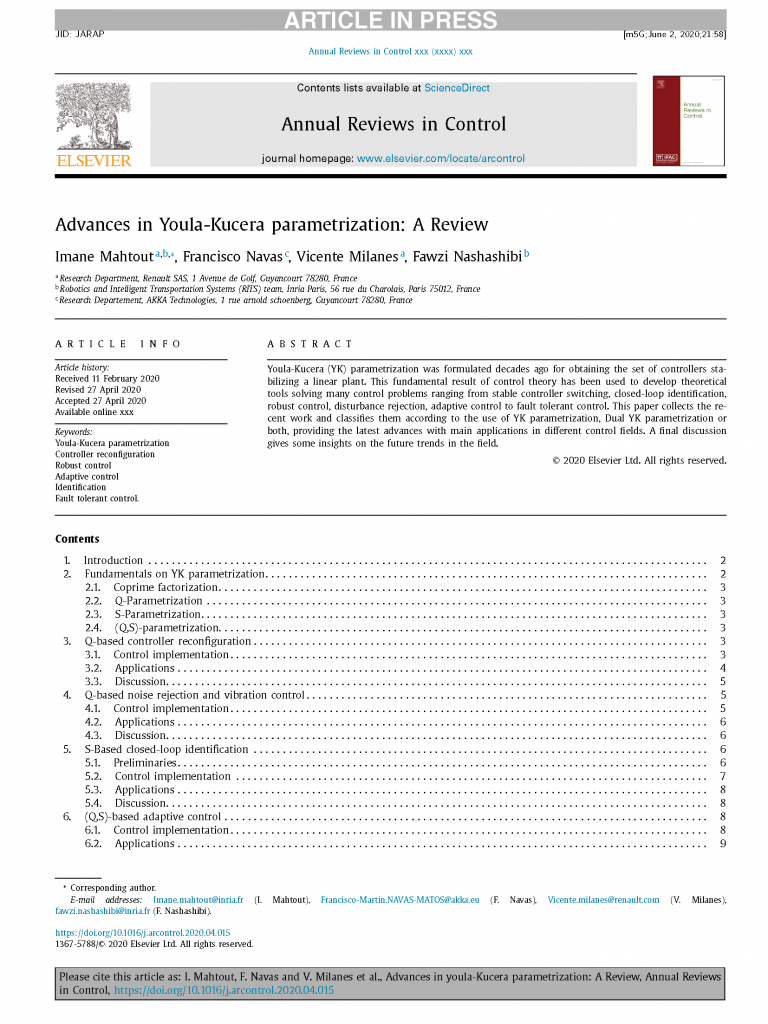In control theory, the Youla-Kučera parametrization is a result formulated decades ago[1],[2],[3],[4] to describe all possible controllers that stabilize a given plant. Later, a dual parametrization was discovered which describes the set of plants stabilized by a given controller. These results have launched an entirely new area of research with exciting applications. The hyphenated name Kučera in the parametrization commemorates its author, prof. Vladimír Kučera, one of the CIIRC CTU founders, Deputy-Director and Head of Scientific Management of Platforms Department.
A survey of the early theoretical development of the subject matter was given by Anderson (Australian National University Canberra)[5] some twenty years ago, with emphasis on optimal control and system identification. Recently[6], the French researchers Mahtout (Renault SAS, Inria Paris), Navas (AKKA Technologies), Milanés (Renault SAS), and Nashashibi (Inria Paris) have collected the latest advances with main applications in different control fields, ranging from stable controller switching, closed-loop identification, optimal control, robust control, disturbance rejection, vibration absorption, adaptive control to fault tolerant control. The list of references has over one hundred items. The authors also offer insight into the future trends in the field. This recent publication Advances in Youla-Kucera parametrization: A Review marks the forty-five years of development of this fundamental result of control theory, indicates a continuing interest in the subject, and shows an impressive range of the industrial applications of the original concept. In Google search tens of thousands of results are returned.
The parametrization formula describes the set of controllers stabilizing a given plant as a function of a single parameter. The engineering significance of the formula is that if one wants to find a stabilizing controller that meets some additional criterion, one can adjust the parameter so that the desired criterion is met. This allows the designer to achieve various different performance specifications, one at a time, and thus simplify the design of complex systems with multiple control objectives. The dual parametrization makes it possible to identify a plant operating in a real control system by identifying the dual parameter instead, which uniquely determines the plant. Interestingly, the identification of the dual parameter is a standard open-loop identification problem.
[1] https://doi.org/10.1016/S1474-6670(17)67787-5
[2] DOI: DOI: 10.1109/TAC.1976.1101139
[3] DOI: 10.1109/TAC.1976.1101223
[4] V. Kučera, Discrete Linear Control: The Polynomial Equation Approach. Chichester, Sussex, UK: Wiley, 1979. ISBN-10: 0471997269, ISBN-13: 978-0471997269
[5] https://doi.org/10.1016/S0005-1098(98)80002-2
[6] I. Mahtout, F. Navas and V. Milanes et al., Advances in Youla-Kucera parametrization: A Review,Annual Reviews in Control, https://doi.org/10.1016/j.arcontrol.2020.04.015




